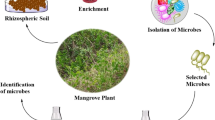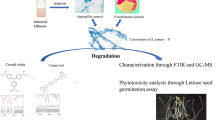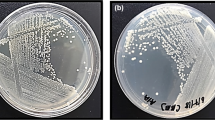Abstract
This study investigates the decolorization potential of actinobacteria from soil towards toxic triphenylmethane (TPM) dyes, i.e., malachite green (MG), methyl violet (MV), crystal violet (CV), and cotton blue (CB). The actinobacterial isolates were first isolated from fresh soil samples, plated onto actinomycetes isolation agar (AIA), and both live and dead cells were prepared to evaluate their decolorization efficiency (DE). Isolates with positive decolorization activities were identified via partial sequencing of the 16S rRNA region. They were revealed as species of Nocardiopsis (N. alba), Streptomyces (S. puniceus, S. bacillaris, S. albolongus, S. acidiscabies, S. albulus, S. pratensis, S. luridiscabiei, S. rubiginosus, S. albidochromogenes), Rhodococcus (R. sovatensis), and Kitasatospora (K. albolonga). Results indicated that all 12 actinobacterial strains (live cells and dead cells) were able to decolorize TPM dyes, although with varying degree of effectiveness. Isolate N. alba (live cells) achieved the highest DE, with 97.0, 95.1, 95.8, and 83.8% (day 14) for MG, MV, CV, and CB, respectively. This was followed by live cells of S. bacillaris with 94.7, 95.1, 90.5, and 63.9% of DE for the same dyes. Live cells appeared to be more effective in decolorizing TPM dyes, suggesting the possible biosorption and biodegradation of dyes. It is concluded that soil actinobacteria tested in this study have the potential for removal of TPM dyes.





Similar content being viewed by others
Data Availability
The data that support the findings of this study are available from the corresponding author, upon request.
References
Ali, S. A. M., & Akthar, N. (2014). A study on bacterial decolorization of crystal violet dye by Clostridium perfringens Pseudomonas aeruginosa and Proteus vulgaris. Research. Article. Biological. Science, 4, 89–96.
An, S.-Y., Min, S.-K., Cha, I.-H., Choi, Y.-L., Cho, Y.-S., Kim, C.-H., et al. (2002). Decolorization of triphenylmethane and azo dyes by Citrobacter sp. Biotechnology Letters, 24(12), 1037–1040.
Anandan, R., Dharumadurai, D., & Manogaran, G. P. (2016). An introduction to actinobacteria. In: Dhanasekaran Y., Jiang Y. (Eds.), Actinobacteria-Basics and Biotechnological Applications: Intechopen. pp. 3–37. https://doi.org/10.5772/62329.
Araujo-Melo, R. d. O., de Oliveira, T. H. B., de Oliveira, C. V. J., de Araújo, J. M., de Sena, K. X., & Coelho, L. C. B. B. (2019). Actinobacteria: a renewable source of bioactive molecules with medical, industrial and pharmacological importance. In: Sosa F.C. (Ed.), Advances and Trends in Biotechnology and Genetics Vol. 1, (pp. 63–79) Book Publisher International. https://doi.org/10.9734/bpi/atbg/v1.
Arocha-Garza, H. F., Canales-Del Castillo, R., Eguiarte, L. E., Souza, V., & De la Torre-Zavala, S. (2017). High diversity and suggested endemicity of culturable Actinobacteria in an extremely oligotrophic desert oasis. PeerJ, 5, e3247.
Boudechiche, N., Mokaddem, H., Sadaoui, Z., & Trari, M. (2016). Biosorption of cationic dye from aqueous solutions onto lignocellulosic biomass (Luffa cylindrica): characterization, equilibrium, kinetic and thermodynamic studies. International Journal of Industrial Chemistry, 7(2), 167–180.
Brenner, D. J., Krieg, N. R., Staley, J. T., & Garrity, G. M. (2005). In: Garrity G.M. (Ed.), Bergey's manual® of systematic bacteriology: volume two: The Proteobacteria, Part A Introductory Essays. Springer. pp. 1–304.
Briceño, G., Pizzul, L., & Diez, M. C. (2013). Biodegradation of pesticides by actinobacteria and their possible application in biobed systems. In: Amoroso M.J., Benimeli C.S., Cuozzo S. (Eds.), Actinobacteria: application in bioremediation and production of industrial enzymes. Taylor & Francis, Boca Raton, FL, p. 286.
Buntić, A., Pavlović, M., Šiler-Marinković, S., & Dimitrijević-Branković, S. (2016). Biological treatment of colored wastewater by Streptomyces fulvissimus CKS 7. Water Science and Technology, 73(9), 2231–2236.
Casas, N., Parella, T., Vicent, T., Caminal, G., & Sarrà, M. (2009). Metabolites from the biodegradation of triphenylmethane dyes by Trametes versicolor or laccase. Chemosphere, 75(10), 1344–1349.
Chen, B.-Y. (2002). Understanding decolorization characteristics of reactive azo dyes by Pseudomonas luteola: toxicity and kinetics. Process Biochemistry, 38(3), 437–446.
Chen, S. H., & Ting, A. S. Y. (2015). Biosorption and biodegradation potential of triphenylmethane dyes by newly discovered Penicillium simplicissimum isolated from indoor wastewater sample. International Biodeterioration & Biodegradation, 103, 1–7.
Chen, S. H., Cheow, Y. L., Ng, S. L., & Ting, A. S. Y. (2019). Biodegradation of triphenylmethane dyes by non-white rot fungus Penicillium simplicissimum: enzymatic and toxicity studies. International Journal of Environmental Research, 13(2), 273–282.
Chittal, V., Gracias, M., Anu, A., Saha, P., & Rao, K. B. (2019). Biodecolorization and biodegradation of Azo Dye Reactive Orange-16 by marine Nocardiopsis sp. Iranian Journal of Biotechnology, 17(3), e1551.
de Almeida, E. J. R., & Corso, C. R. (2016). Acid blue 161: Decolorization and toxicity analysis after microbiological treatment. Water, Air, & Soil Pollution, 227(12), 468.
Eizuka, T., Ito, A., & Chida, T. (2003). Degradation of ipconazole by microorganisms isolated from paddy soil. Journal of Pesticide Science, 28(2), 200–207.
El-Sersy, N. A., Abou-Elela, G. M., Hassan, S. W., & Abd-Elnaby, H. (2011). Bioremediation of acid fast red dye by Streptomyces globosus under static and shake conditions. African Journal of Biotechnology, 10(17), 3467–3474.
Gill, P., Arora, D., & Chander, M. (2002). Biodecolourization of azo and triphenylmethane dyes by Dichomitus squalens and Phlebia spp. Journal of Industrial Microbiology and Biotechnology, 28(4), 201–203.
Goodfellow, M., Kämpfer, P., Busse, H.-J., Trujillo, M. E., & Suzuki, K.-i., Ludwig, W., et al. (2012). Bergey's manual® of systematic bacteriology: volume five the Actinobacteria. Part A: Springer.
Hema, T., Getha, K., Tan, G., Sahira, H. L., Syamil, A. M., & Fairuz, M. N. (2014). Actinobacterial isolates from tin tailings and forest soil for bioremediation of heavy metals. Journal of Tropical Forest Science, 26, 153–162.
Jasińska, A., Paraszkiewicz, K., Słaba, M., & Długoński, J. (2015). Microbial decolorization of triphenylmethane dyes. In Singh S. (Ed.), Microbial Degradation of Synthetic Dyes in Wastewaters, Springer. pp. 169–186.
Jiang, J., He, X., & Cane, D. E. (2007). Biosynthesis of the earthy odorant geosmin by a bifunctional Streptomyces coelicolor enzyme. Nature Chemical Biology, 3(11), 711.
Kaushik, P., & Malik, A. (2015). Mycoremediation of synthetic dyes: an insight into the mechanism, process optimization and reactor design. In: Singh S (Ed.), Microbial Degradation of Synthetic dyes in Wastewaters, Springer. pp. 1–25.
Khalid, A., & Mahmood, S. (2015). The biodegradation of azo dyes by actinobacteria. In: Singh S. (Ed.), Microbial Degradation of Synthetic Dyes in Wastewaters, Springer. pp. 293–314.
Kuhad, R., Sood, N., Tripathi, K., Singh, A., & Ward, O. (2004). Developments in microbial methods for the treatment of dye effluents. Advances in Applied Microbiology, 56, 185–213.
Li, G., Peng, L., Ding, Z., Liu, Y., Gu, Z., Zhang, L., et al. (2014). Decolorization and biodegradation of triphenylmethane dyes by a novel Rhodococcus qingshengii JB301 isolated from sawdust. Annals of Microbiology, 64(4), 1575–1586.
Li, Q., Chen, X., Jiang, Y., & Jiang, C. (2016). Morphological identification of actinobacteria. InL Dhanasekaran D, Jiang Y (Eds.), Actinobacteria-Basics and Biotechnological Applications. Rijeka, Croatia: InTech Open. pp. 59–81.
Mahmood, R., Sharif, F., Ali, S., & Hayyat, M. U. (2015). Enhancing the decolorizing and degradation ability of bacterial consortium isolated from textile effluent affected area and its application on seed germination. The Scientific World Journal, 2015, 628195.
Malisorn, K., Embaen, S., Sribun, A., Saeng-in, P., Phongsopitanun, W., & Tanasupawat, S. (2020). Identification and antimicrobial activities of Streptomyces, Micromonospora, and Kitasatospora strains from rhizosphere soils. Journal of Applied Pharmaceutical Science, 10(02), 123–128.
Mane, U., Gurav, P., Deshmukh, A., & Govindwar, S. (2008). Degradation of textile dye reactive navy–blue Rx (reactive blue–59) by an isolated Actinomycete Streptomyces krainskii SUK–5. Malaysian Journal of Microbiology, 4(2), 1–5.
Maniyam, M. N., Sjahrir, F., & Hari, M. (2018). Decolourization of methylene blue by Rhodococcus strain UCC 0003. International Journal of Environmental Science and Development, 9(11), 322–326.
Maniyam, M. N., Ibrahim, A. L., & Cass, A. E. (2020). Decolourization and biodegradation of azo dye methyl red by Rhodococcus strain UCC 0016. Environmental Technology, 41(1), 71–85.
Marcharchand, S., & Ting, A. S. Y. (2017). Trichoderma asperellum cultured in reduced concentrations of synthetic medium retained dye decolourization efficacy. Journal of Environmental Management, 203, 542–549.
Margesin, R., Moertelmaier, C., & Mair, J. (2013). Low-temperature biodegradation of petroleum hydrocarbons (n-alkanes, phenol, anthracene, pyrene) by four actinobacterial strains. International Biodeterioration & Biodegradation, 84, 185–191.
Moopantakath, J., & Kumavath, R. (2018). Bio-augmentation of actinobacteria and their role in dye decolorization. In Prasad R., Gill SS, Tuleja N. (Eds.), New and Future Developments in Microbial Biotechnology and Bioengineering. Elsevier. pp. 297–304.
Nacèra, Y., & Aicha, B. (2006). Equilibrium and kinetic modelling of methylene blue biosorption by pretreated dead streptomyces rimosus: effect of temperature. Chemical Engineering Journal, 119(2–3), 121–125.
Nouioui, I., Carro, L., García-López, M., Meier-Kolthoff, J. P., Woyke, T., Kyrpides, N. C., et al. (2018). Genome-based taxonomic classification of the phylum Actinobacteria. Frontiers in Microbiology, 9, 2007.
Oplatowska, M., Donnelly, R. F., Majithiya, R. J., Kennedy, D. G., & Elliott, C. T. (2011). The potential for human exposure, direct and indirect, to the suspected carcinogenic triphenylmethane dye brilliant green from green paper towels. Food and Chemical Toxicology, 49(8), 1870–1876.
Pant, D., Singh, A., Satyawali, Y., & Gupta, R. (2007). Effect of carbon and nitrogen source amendment on synthetic dyes decolourizing efficiency of white-rot fungus, Phanerochaete chrysosporium. Journal of Environmental Biology, 29(1), 79.
Parshetti, G., Parshetti, S., Telke, A., Kalyani, D., Doong, R., & Govindwar, S. P. (2011). Biodegradation of crystal violet by Agrobacterium radiobacter. Journal of Environmental Sciences, 23(8), 1384–1393.
Patil, P. B., Zeng, Y., Coursey, T., Houston, P., Miller, I., & Chen, S. (2010). Isolation and characterization of a Nocardiopsis sp. from honeybee guts. FEMS Microbiology Letters, 312(2), 110–118.
Priyaragini, S., Sathishkumar, S., & Bhaskararao, K. (2013). Biosynthesis of silver nanoparticles using actinobacteria and evaluating its antimicrobial and cytotoxicity activity. International Journal of Pharmacy and Pharmaceutical Sciences, 5(2), 709–712.
Przystaś, W., Zabłocka-Godlewska, E., & Grabińska-Sota, E. (2012). Biological removal of azo and triphenylmethane dyes and toxicity of process by-products. Water, Air, & Soil Pollution, 223(4), 1581–1592.
Przystaś, W., Zabłocka-Godlewska, E., & Grabińska-Sota, E. (2018). Efficiency of decolorization of different dyes using fungal biomass immobilized on different solid supports. Brazilian Journal of Microbiology, 49(2), 285–295.
Qi, J., Schlömann, M., & Tischler, D. (2016). Biochemical characterization of an azoreductase from Rhodococcus opacus 1CP possessing methyl red degradation ability. Journal of Molecular Catalysis B: Enzymatic, 130, 9–17.
Raja, M. M. M., Raja, A., Salique, S. M., & Gajalakshmi, P. (2016). Studies on effect of marine actinomycetes on amido black (azo dye) decolorization. Journal of Chemical and Pharmaceutical Research, 8(8), 640–644.
Saranraj, P., & Sivasakthivelan, P. (2014). Prevalence of bacterial isolates in textile dye effluent and analysis of its dye degrading efficiency. Middle-East Journal of Scientific Research, 21(5), 721–725.
Seyis, I., & Subasioglu, T. (2008). Comparison of live and dead biomass of fungi on decolorization of methyl orange. African Journal of Biotechnology, 7(12), 2212–2216.
Shah, M. (2014). Efficacy of Rhodococcus rhodochrous in microbial degradation of toluidine dye. Journal of Petroleum & Environmental Biotechnology, 5(4), 187.
Shah, M. P., Patel, K. A., Nair, S. S., & Darji, A. (2013). Bioremoval of azo dye Reactive Red by Bacillus spp. ETL-1982. Journal of Bioremediation and Biodegradation, 4(3):1000186.
ShanmugaPriya, M. (2016). Decolorization of azodyes by marine actinomycetes. Advance Research Journal of Life Sciences, 2(2), 1–5.
Sharma, M., Dangi, P., & Choudhary, M. (2014). Actinomycetes: source, identification, and their applications. International Journal of Current Microbiology and Applied Sciences, 3(2), 801–832.
Shedbalkar, U., Dhanve, R., & Jadhav, J. (2008). Biodegradation of triphenylmethane dye cotton blue by Penicillium ochrochloron MTCC 517. Journal of Hazardous Materials, 157(2–3), 472–479.
Shekhar, S. K., Godheja, J., Modi, D., & Peter, J. K. (2014). Growth potential assessment of Actinomycetes isolated from petroleum contaminated soil. Journal of Bioremediation & Biodegredation, 5(7), 1.
Shrivastava, P., Kumar, R., Yandigeri, M. S., Malviya, N., & Arora, D. K. (2015). Isolation and characterization of Streptomycetes with plant growth promoting potential from mangrove ecosystem. Polish Journal of Microbiology, 64(4), 339–349.
Singh, K., Kumar, P., & Srivastava, R. (2017). An overview of textile dyes and their removal techniques: Indian perspective. Pollution Research, 36(4), 790–797.
Stach, J. E., Maldonado, L. A., Ward, A. C., Goodfellow, M., & Bull, A. T. (2003). New primers for the class Actinobacteria: application to marine and terrestrial environments. Environmental Microbiology, 5(10), 828–841.
Stammati, A., Nebbia, C., De Angelis, I., Albo, A. G., Carletti, M., Rebecchi, C., et al. (2005). Effects of malachite green (MG) and its major metabolite, leucomalachite green (LMG), in two human cell lines. Toxicology In Vitro, 19(7), 853–858.
Sugumar, S., & Thangam, E. (2012). Biodegradation and decolorization of reactive orange 16 by Nocardiopsis alba soil isolate. Journal of Bioremediation & Biodegradation, 3(6), 155.
Ting, A. S. Y., Lee, M. V. J., Chow, Y. Y., & Cheong, S. L. (2016). Novel exploration of endophytic Diaporthe sp. for the biosorption and biodegradation of triphenylmethane dyes. Water, Air, & Soil Pollution, 227(4), 109.
Velkova, Z. Y., Kirova, G. K., Stoytcheva, M. S., & Gochev, V. (2018). Biosorption of Congo Red and methylene blue by pretreated waste Streptomyces fradiae biomass–equilibrium, kinetic and thermodynamic studies. Journal of the Serbian Chemical Society, 83(1), 107–120.
Vijayakumar, R., & Malathi, R. (2014). Isolation, characterization and antibacterial activity of actinobacteria from dye polluted soils of Tirupur. Medicine and Biology, 16(1), 43–48.
Vijayaraghavan, J., Basha, S. S., & Jegan, J. (2013). A review on efficacious methods to decolorize reactive azo dye. Journal of Urban and Environmental Engineering, 7(1), 30–47.
Wolińska, A., Górniak, D., Zielenkiewicz, U., Kuźniar, A., Izak, D., Banach, A., et al. (2019). Actinobacteria structure in autogenic, hydrogenic and lithogenic cultivated and non-cultivated soils: a culture-independent approach. Agronomy, 9(10), 598.
Yun, B.-R., Malik, A., & Kim, S. B. (2020). Genome based characterization of Kitasatospora sp. MMS16-BH015, a multiple heavy metal resistant soil actinobacterium with high antimicrobial potential. Gene, 733, 144379.
Acknowledgments
The authors would like to thank Monash University Malaysia for the research funding and facilities.
Funding
The research was funded by Monash University Malaysia.
Author information
Authors and Affiliations
Corresponding author
Ethics declarations
Conflict of Interest
The authors declare that they have no conflict of interest.
Ethics Approval
Not applicable.
Consent to Participate
Not applicable.
Consent for Publication
The authors agree that this paper to be published by Journal of Water, Air & Soil Pollution.
Code Availability
Not applicable.
Additional information
Publisher’s Note
Springer Nature remains neutral with regard to jurisdictional claims in published maps and institutional affiliations.
Supplementary Information
ESM 1
(DOCX 1311 kb)
Rights and permissions
About this article
Cite this article
Adenan, N.H., Lim, Y.Y. & Ting, A.S.Y. Discovering Decolorization Potential of Triphenylmethane Dyes by Actinobacteria from Soil. Water Air Soil Pollut 231, 560 (2020). https://doi.org/10.1007/s11270-020-04928-w
Received:
Accepted:
Published:
DOI: https://doi.org/10.1007/s11270-020-04928-w




